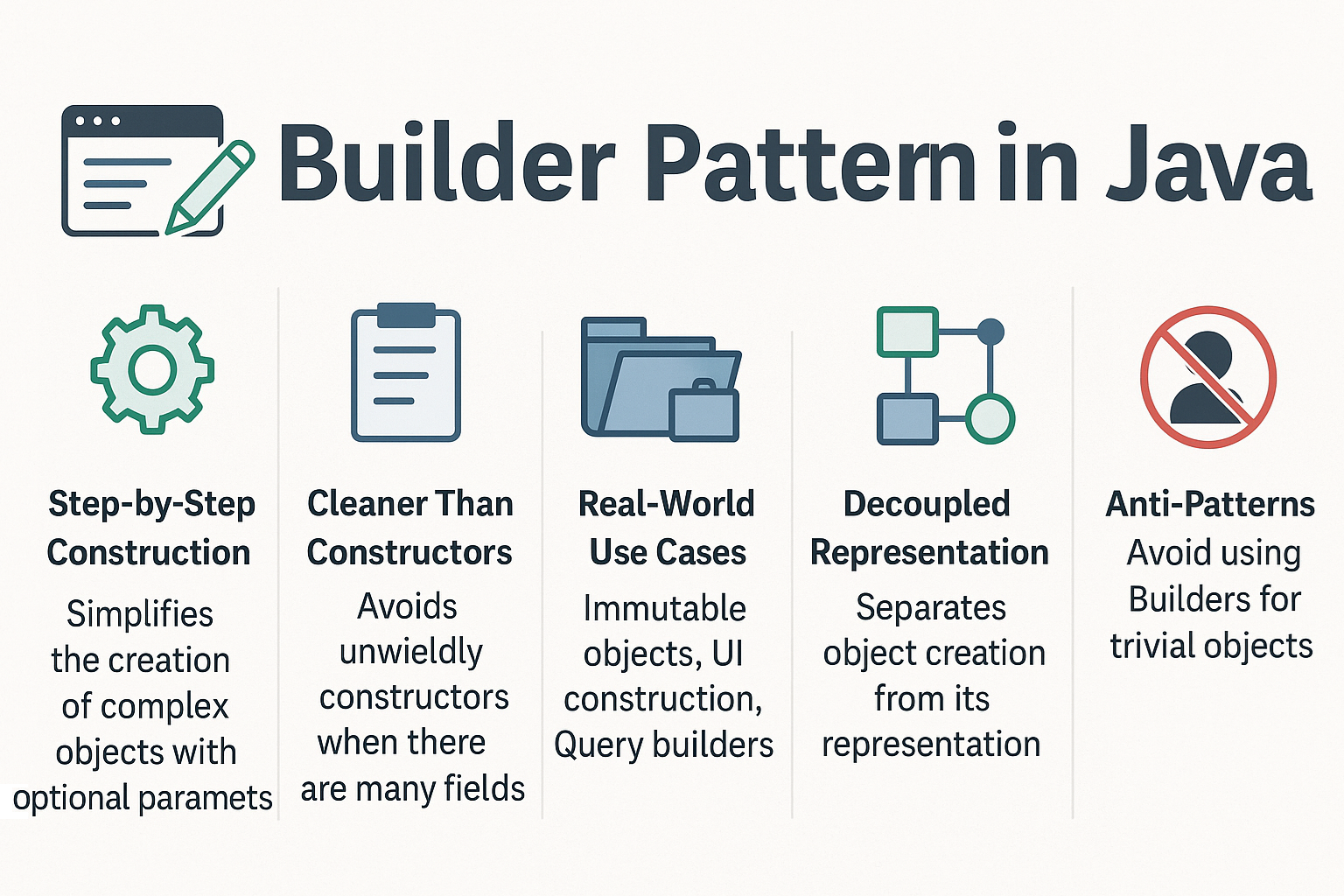Introduction
The Builder Pattern is a creational design pattern that helps construct complex objects step by step. It decouples the construction process from the object’s representation, allowing the same construction logic to create different representations.
Why Builder Pattern Matters
In Java, constructors can become unwieldy when dealing with many optional parameters. The Builder Pattern offers a cleaner, more readable, and more maintainable way to construct such objects.
Core Intent and Participants
- Intent: Separate the construction of a complex object from its representation so the same construction process can create different representations.
Participants
Builder: Specifies an abstract interface for creating parts of a Product.ConcreteBuilder: Implements the Builder interface and keeps track of the representation.Product: The complex object under construction.Director(optional): Constructs the object using the Builder interface.
UML Diagram (Text)
+-------------+ +-----------------+
| Product |<------| Builder |
+-------------+ +-----------------+
^
|
+--------------------+
| ConcreteBuilder |
+--------------------+
^
|
+----------+
| Director |
+----------+
Real-World Use Cases
- Creating immutable objects (e.g., Lombok @Builder)
- Constructing HTML/XML documents
- Building complex UI elements
- Query builders in SQL
- Creating
HttpRequestobjects in Java 11+
Common Implementation in Java
Example: Building a Computer Object
Step 1: Product
public class Computer {
private String CPU;
private String RAM;
private String storage;
private boolean graphicsCard;
private Computer(Builder builder) {
this.CPU = builder.CPU;
this.RAM = builder.RAM;
this.storage = builder.storage;
this.graphicsCard = builder.graphicsCard;
}
public static class Builder {
private String CPU;
private String RAM;
private String storage;
private boolean graphicsCard;
public Builder(String CPU, String RAM) {
this.CPU = CPU;
this.RAM = RAM;
}
public Builder storage(String storage) {
this.storage = storage;
return this;
}
public Builder graphicsCard(boolean graphicsCard) {
this.graphicsCard = graphicsCard;
return this;
}
public Computer build() {
return new Computer(this);
}
}
@Override
public String toString() {
return CPU + " | " + RAM + " | " + storage + " | " + (graphicsCard ? "With GPU" : "No GPU");
}
}
Step 2: Client Code
public class BuilderDemo {
public static void main(String[] args) {
Computer gamingPC = new Computer.Builder("Intel i9", "32GB")
.storage("1TB SSD")
.graphicsCard(true)
.build();
System.out.println(gamingPC);
}
}
✅ Clean, readable, and extensible construction.
Pros and Cons
✅ Pros
- Handles complex object construction cleanly
- Improves code readability (especially for objects with many params)
- Supports immutability
- Enables fluent API style
❌ Cons
- Slightly more code to write initially
- Can be overkill for simple objects
Anti-Patterns and Misuse
- Using Builder for trivial objects (YAGNI violation)
- Creating inconsistent objects by missing required fields
- Forgetting immutability in the built object
Comparison with Other Patterns
| Pattern | Purpose | Object Type | Complexity | Use Case |
|---|---|---|---|---|
| Factory Method | Create one object | Single Product | Low | Notification, Shape |
| Abstract Factory | Create related objects | Product Families | Medium | UI Toolkit |
| Builder | Step-by-step creation of complex obj | Complex Product | Medium | Computer, Document, UI Components |
Refactoring Legacy Code
Before (Constructor Overload)
public class Computer {
public Computer(String cpu, String ram, String storage, boolean graphicsCard) {
// messy constructor with many params
}
}
After Using Builder
Computer pc = new Computer.Builder("Intel i7", "16GB")
.storage("512GB SSD")
.graphicsCard(false)
.build();
✅ Much more readable and maintainable.
Best Practices
- Always validate required fields before building
- Make built object immutable
- Use
@Builderwith Lombok if you prefer annotation-based syntax - Add
toString()andequals()for better debugging
Real-World Analogy
Think of ordering a pizza.
You specify base ingredients (crust, cheese) and then customize with toppings (onions, peppers, jalapenos). The chef (Builder) constructs your unique pizza step-by-step. You don't need a separate constructor for every combination.
Java Version Relevance
- Java 8+: Use fluent interfaces with method chaining
- Java 11+:
HttpRequest.newBuilder()uses Builder Pattern - Java 14+: Combine with Records to build immutable DTOs
Conclusion & Key Takeaways
- Builder Pattern simplifies construction of complex objects.
- Improves readability and flexibility.
- Especially helpful for immutable or optional-field-heavy classes.
- Great alternative to constructor telescoping or factory overuse.
FAQ – Builder Pattern in Java
1. What is the Builder Pattern?
A pattern that constructs complex objects step-by-step using a fluent interface.
2. When should I use it?
When constructors get too large or have many optional parameters.
3. Can I use it with immutable classes?
Yes, Builder is perfect for immutability.
4. How does it differ from Factory Pattern?
Builder assembles the object step-by-step; Factory creates in one step.
5. What are some Java classes using this pattern?
StringBuilder, HttpRequest.Builder, Lombok @Builder
6. Does it support method chaining?
Yes, and that’s a key feature of fluent APIs.
7. Should I validate inputs in the builder?
Yes, especially before building the final object.
8. What’s the role of the Director?
Optional. It manages the construction process.
9. Can I combine Builder with Lombok?
Yes, use @Builder annotation.
10. Is it memory-efficient?
Yes. Though it creates a builder object, the overall footprint is small and the benefits outweigh the cost.
This article is part of the "Design Patterns in Java" series. Next up: Prototype Pattern!
